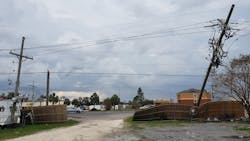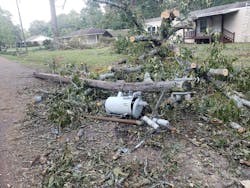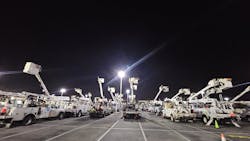The Evolving Challenges of Storm Preparedness and the Role of Volunteer Utility Teams
Key Highlights
- Storm response teams are highly trained volunteers who work collaboratively across utility organizations to restore power after natural disasters.
- Preparation for storm season involves extensive planning, including deploying experienced technicians and leveraging digital technologies for damage assessment.
- Damage assessment crews often serve as first responders, providing emergency aid and emotional support to storm-affected communities.
In the electric utility industry, those who participate in storm response have a special bond. You can feel it in the planning sessions that start long before storm season begins. You can sense it at the learning forums where storm response professionals come together to share best practices. And it is palpable in the staging areas where crews from utilities and support organizations assemble and prepare to drive toward the storm — while everyone else is evacuating in the opposite direction.
Many of the best memories I’ve made and closest friendships I have in the industry have been a result of storm response duties, which have been an important part of my work throughout my career. My last storm response deployment was in 2017, where I supported Duke Energy in Florida for 23 days after a major hurricane. And that work continues today with my position overseeing teams that serve as an extension of utilities across the Southeast.
No matter the location or circumstance, every storm response staging area feels familiar to me. The temperature of the sandwiches and quality of the coffee may vary, but one thing stays constant — there’s always a calm confidence that comes from a group of people who are ready to do something important and are fully prepared for the challenges ahead. That consistency is one of the things that makes me deeply proud to be part of the community of people who work together on storm response.
Responding to Natural Disasters
While some things will never change about storm response operations, one thing that is evolving is the year-round unpredictability of natural disasters. Not only are the severity and frequency of major storms increasing, but the geographic impact of these storms has widened and become harder to predict.
For example, areas that have historically been at lower risk for significant hurricane damage have been hit hard in recent years. Last year’s hurricane damage in western North Carolina is a powerful example of that. But it’s not just hurricanes. Areas where tornadoes have not been prevalent have faced major damage in recent years. Ice storms have hit regions that typically don’t face outages from ice buildup on grid infrastructure. And wildfires, which are so often sparked by lightning from thunderstorms, are regularly posing major risks to utility infrastructure across the entire nation rather than just in Western states.
All these factors make storm preparedness even more critical, and it is inspiring to see how organizations across the utility industry collaborate to achieve the planning, adaptability and cooperation needed to meet these challenges. For my team, preparation for storm season has been underway for several months and includes extensive planning with the utilities we serve. We work as an extension of utilities’ own crews and contractors, allowing utilities to quickly expand the number of experienced transmission and distribution (T&D) technicians, designers and engineers who can be deployed for damage assessment and recovery planning.
Volunteering for Storm Response
Our storm response teams are comprised of volunteers, and we work on a mutual aid model that mirrors the collaboration so many utilities use in response to major events. For storm response deployments last year, we drew in TRC employees from across the country to work on incidents in the Southeast. They came from as far as Texas, Virginia, Ohio and a long list of other locations to join local resources, allowing us to deploy 200 teams to emergency areas.
We always work in two-person teams to ensure safety. The senior team member conducts damage assessment and maps the required design and engineering work. These are highly experienced utility professionals who are often former line personnel with decades of experience in T&D and in emergency response. The assessor is paired with a more junior utility professional, providing an intensive apprenticeship in one of the most important roles of his or her career. I am incredibly impressed by the abilities of the next generation of professionals who adept at using digital technologies for the design work that is central to storm response. This bodes well for the future of our industry as storm response becomes even more critical.
We work closely with utilities to deploy these teams exactly where and when they are most needed. We can then re-deploy them to support other utilities that have infrastructure impacted by the same emergency or utilities that are facing damage from a different emergency. We have a war room to orchestrate the cross-organization communications and logistics for all of this, which is expertly managed by Chris Duncan, TRC’s storm director.
Assessing the Damage
Everyone who serves in a storm response role knows how often damage assessment teams also act as first responders. And the stories of crews’ bravery, selflessness and public service are an enormous testament to our industry. So often, damage assessment teams are the first to arrive in an impacted neighborhood, often finding people in dire circumstances. The crews give out water, food and blankets to people who have lost everything. Crews often save people from drowning, rescue trapped victims, perform CPR and provide lifesaving first aid until EMTs can arrive on scene.
Being first on scene also means storm response crews are among the first to be able to provide emotional support to storm survivors. That makes empathy and selflessness important qualities for people on storm response assignments. They are helping people who are often in shock, who have had their lives impacted in a traumatic way and need far more than just power or food. Again, and again our crew members rise to the occasion. They quickly become part of the community, too, given that the T&D rebuilding process can often take weeks after a major storm.
Honoring the Storm Responders
With qualities like bravery, selflessness, empathy and calmness under pressure, it is no surprise that many of the best storm responders in our industry are military veterans. After careers in the military, they became line and/or design personnel to apply their skills building and managing mission critical infrastructure, and their military experience becomes an enormous asset during storm response missions.
This work is dangerous, the deployments are often long and the accommodations are never glamourous (especially when you sleep in your truck), but every year selfless people in our industry rush to volunteer for these roles despite the risks. With storm season rapidly approaching, it is important to recognize how much work has gone into preparing for the emergencies that will occur in the coming months. There are a lot of jobs where it is hard to feel like you are truly making a difference in the world. This isn’t one of them. In advance of what will likely be a very busy storm season, it is an honor to be serving in a role that supports communities facing these emergencies.
About the Author
Joel Mullinax
Joel Mullinax ([email protected]) is vice president of distribution operations for the southeastern and southwestern United States at TRC, a global professional services firm providing integrated strategy, consulting, engineering and applied technologies in support of the energy transition. In this role, he oversees the distribution services that TRC provides to utilities in the South. This role includes responsibility for strategy, implementation and management of TRC’s storm response services that enhance the ability of utilities to recover from disasters that impact the communities they serve.


